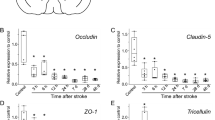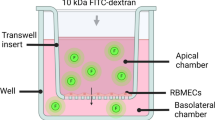Abstract
The blood–brain barrier (BBB) has become a major focus of attention in cerebral pathophysiology and disease progression in the central nervous system. Endothelial tight junctions, the basal lamina, and perivascular astrocytes are jointly referred to as BBB or neurovascular unit. Around the cerebral endothelial cells is the basal lamina composed primarily of laminin, fibronectin, and heparan sulfate. The basal lamina provides a structural barrier to extravasation of cellular blood elements and anchors endothelial cells to astrocytes. Barriers limiting transport into and out of the brain are found at the tight junction proteins and at the basal lamina. The relative contribution of these two sites has not been studied, but it is likely that both are disrupted to some extent in various injury scenarios. We have shown that activation of matrix metalloproteinases (MMPs) opens the BBB by degrading tight junction proteins (claudin-5 and occludin) and increases BBB permeability after stroke, and that an MMP inhibitor prevents degradation of tight junction proteins and attenuates BBB disruption.
Access this chapter
Tax calculation will be finalised at checkout
Purchases are for personal use only
Similar content being viewed by others
References
Vracko, R., Basal lamina scaffold-anatomy and significance for maintenance of orderly tissue structure. Am J Pathol, 1974. 77(2): p. 314–46.
Hawkins, B.T. and T.P. Davis, The blood-brain barrier/neurovascular unit in health and disease. Pharmacol Rev, 2005. 57(2): p. 173–85.
Ballabh, P., A. Braun, and M. Nedergaard, The blood-brain barrier: an overview: structure, regulation, and clinical implications. Neurobiol Dis, 2004. 16(1): p. 1–13.
Brightman, M.W. and T.S. Reese, Junctions between intimately apposed cell membranes in the vertebrate brain. J Cell Biol, 1969. 40(3): p. 648–77.
Liebner, S., et al., Correlation of tight junction morphology with the expression of tight junction proteins in blood-brain barrier endothelial cells. Eur J Cell Biol, 2000. 79(10): p. 707–17.
Papadopoulos, M.C., et al., Occludin expression in microvessels of neoplastic and non-neoplastic human brain. Neuropathol Appl Neurobiol, 2001. 27(5): p. 384–95.
Furuse, M., et al., Occludin: a novel integral membrane protein localizing at tight junctions. J Cell Biol, 1993. 123(6 Pt 2): p. 1777–88.
Haskins, J., et al., ZO-3, a novel member of the MAGUK protein family found at the tight junction, interacts with ZO-1 and occludin. J Cell Biol, 1998. 141(1): p. 199–208.
Itoh, M., et al., Involvement of ZO-1 in cadherin-based cell adhesion through its direct binding to alpha catenin and actin filaments. J Cell Biol, 1997. 138(1): p. 181–92.
Hirase, T., et al., Regulation of tight junction permeability and occludin phosphorylation by Rhoa-p160ROCK-dependent and -independent mechanisms. J Biol Chem, 2001. 276(13): p. 10423–31.
Hirase, T., et al., Occludin as a possible determinant of tight junction permeability in endothelial cells. J Cell Sci, 1997. 110 (Pt 14): p. 1603–13.
Kanda, T., Y. Numata, and H. Mizusawa, Chronic inflammatory demyelinating polyneuropathy: decreased claudin-5 and relocated ZO-1. J Neurol Neurosurg Psychiatry, 2004. 75(5): p. 765–9.
Wen, H., et al., Selective decrease in paracellular conductance of tight junctions: role of the first extracellular domain of claudin-5. Mol Cell Biol, 2004. 24(19): p. 8408–17.
Dobrogowska, D.H. and A.W. Vorbrodt, Immunogold localization of tight junctional proteins in normal and osmotically-affected rat blood-brain barrier. J Mol Histol, 2004. 35(5): p. 529–39.
Matter, K. and M.S. Balda, Holey barrier: claudins and the regulation of brain endothelial permeability. J Cell Biol, 2003. 161(3): p. 459–60.
Honda, M., et al., Adrenomedullin improves the blood-brain barrier function through the expression of claudin-5. Cell Mol Neurobiol, 2006. 26(2): p. 109–18.
Furuse, M., et al., Claudin-1 and -2: novel integral membrane proteins localizing at tight junctions with no sequence similarity to occludin. J Cell Biol, 1998. 141(7): p. 1539–50.
Nitta, T., et al., Size-selective loosening of the blood-brain barrier in claudin-5-deficient mice. J Cell Biol, 2003. 161(3): p. 653–60.
Huber, J.D., R.D. Egleton, and T.P. Davis, Molecular physiology and pathophysiology of tight junctions in the blood-brain barrier. Trends Neurosci, 2001. 24(12): p. 719–25.
Mark, K.S. and T.P. Davis, Cerebral microvascular changes in permeability and tight junctions induced by hypoxia-reoxygenation. Am J Physiol Heart Circ Physiol, 2002. 282(4): p. H1485-94.
Witt, K.A., et al., Effects of hypoxia-reoxygenation on rat blood-brain barrier permeability and tight junctional protein expression. Am J Physiol Heart Circ Physiol, 2003. 285(6): p. H2820-31.
Yamagata, K., et al., Hypoxia-induced changes in tight junction permeability of brain capillary endothelial cells are associated with IL-1beta and nitric oxide. Neurobiol Dis, 2004. 17(3): p. 491–9.
Yang, Y., et al., Matrix metalloproteinase-mediated disruption of tight junction proteins in cerebral vessels is reversed by synthetic matrix metalloproteinase inhibitor in focal ischemia in rat. J Cereb Blood Flow Metab, 2007. 27(4): p. 697–709.
Wolburg, H., et al., Localization of claudin-3 in tight junctions of the blood-brain barrier is selectively lost during experimental autoimmune encephalomyelitis and human glioblastoma multiforme. Acta Neuropathol (Berl), 2003. 105(6): p. 586–92.
Forster, C., Tight junctions and the modulation of barrier function in disease. Histochem Cell Biol, 2008. 130(1): p. 55–70.
Nishida, Y., et al., Screening for control genes in mouse hippocampus after transient forebrain ischemia using high-density oligonucleotide array. J Pharmacol Sci, 2006. 101(1): p. 52–7.
Author information
Authors and Affiliations
Corresponding author
Editor information
Editors and Affiliations
Rights and permissions
Copyright information
© 2011 Springer Science+Business Media, LLC
About this protocol
Cite this protocol
Yang, Y., Rosenberg, G.A. (2011). MMP-Mediated Disruption of Claudin-5 in the Blood–Brain Barrier of Rat Brain After Cerebral Ischemia. In: Turksen, K. (eds) Claudins. Methods in Molecular Biology, vol 762. Humana Press, Totowa, NJ. https://doi.org/10.1007/978-1-61779-185-7_24
Download citation
DOI: https://doi.org/10.1007/978-1-61779-185-7_24
Published:
Publisher Name: Humana Press, Totowa, NJ
Print ISBN: 978-1-61779-184-0
Online ISBN: 978-1-61779-185-7
eBook Packages: Springer Protocols




